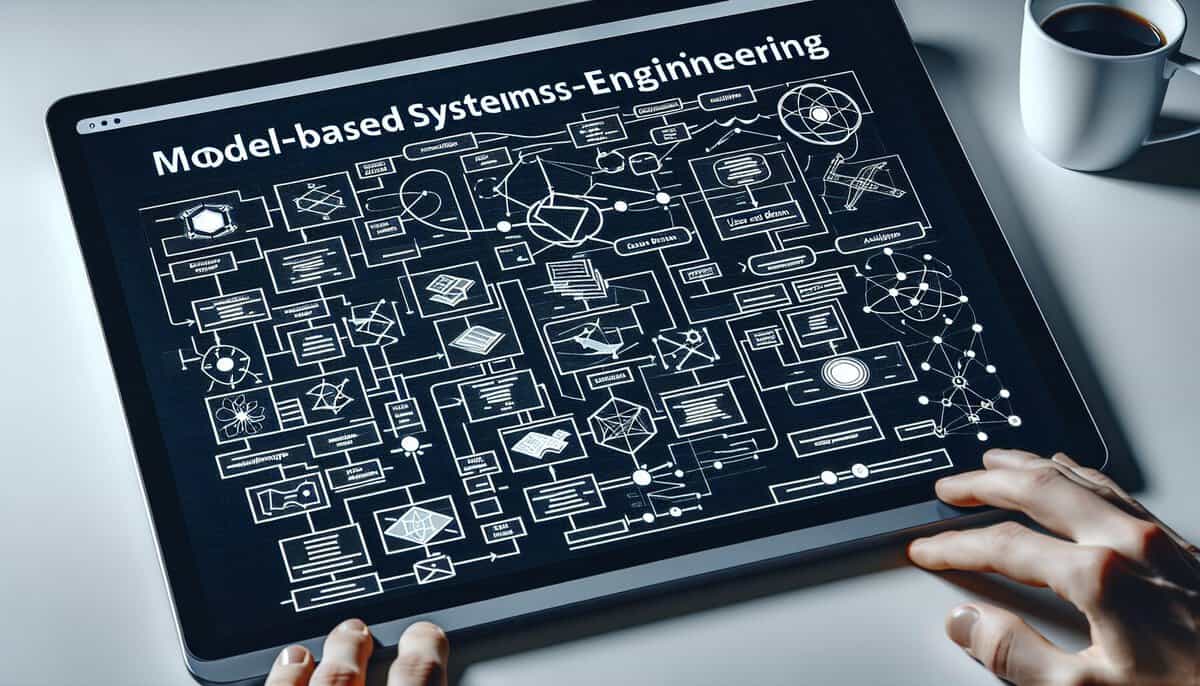مع التطور السريع للصناعات، ارتفع اعتماد هندسة النظم القائمة على النماذج (MBSE)، حيث تشير الدراسات إلى أن المؤسسات التي تستخدم منهجيات هندسة النظم القائمة على النماذج يمكن أن تقلل من وقت التطوير بما يصل إلى 301 تيرابايت في 9 تيرابايت (المصدر: INCOSE). ومن الأمور المحورية في هذا التحول لغة نمذجة النظم (SysML)، وهي لغة نمذجة شاملة مصممة لدعم المواصفات والتحليل والتصميم و التحقق للأنظمة المعقدة. ستقوم هذه المقالة بتشريح الفروق الدقيقة في SysML، بدءًا من مجموعتها المتنوعة من تسعة أنواع من الرسوم البيانية - بما في ذلك حالة الاستخدام، وتعريف الكتل، ومخططات الأنشطة - إلى بنياتها اللغوية الهامة مثل الكتل والمنافذ والواجهات. من خلال دراسة فوائد SysML لتصميم الأنظمة واستكشاف الأدوات والبرمجيات الأساسية للنمذجة الفعالة، نهدف إلى توضيح دورها المحوري في هندسة أنظمة الطيران والسيارات والدفاع الحديثة. علاوةً على ذلك، سنتناول العلاقة بين SysML و UML، مما يثري فهمك لأدوات النمذجة هذه ضمن الممارسات الهندسية المعاصرة.
النقاط الرئيسية

- يدعم SysML التمثيل المنظم لمتطلبات النظام.
- تسعة أنواع من المخططات تخدم وظائف النمذجة المتميزة بفعالية.
- تسهل التركيبات الرئيسية تصميم النظام القوي وتجريده.
- توجد أدوات متنوعة لتطوير نموذج SysML المبسط.
- توسع SysML قدرات UML لتشمل مجالات هندسة النظم.
مدخل إلى هندسة النظم القائمة على النماذج MBSE ودور SysML
تمثل هندسة النظم المستندة إلى النماذج (MBSE) نقلة نوعية في هندسة النظم، حيث تنتقل من النهج المرتكز على الوثائق إلى نهج يرتكز على النماذج. ويسهل هذا التطور إنشاء وتحليل التحقق من الصحةوالتحقق من تصاميم النظام من خلال استخدام النماذج المرئية بدلاً من التوثيق النصي التقليدي. يعزز MBSE التواصل بين أصحاب المصلحة من خلال توفير وجهات نظر موحدة لمكونات النظام وترابطها، مما يقلل من الغموض ويحسن الجودة الشاملة للعمل الهندسي. وتشير إحدى الإحصائيات التوضيحية إلى أن المؤسسات التي تتبنى هندسة البرمجة والهندسة الوسيطة والهندسة البرمجية متوسطة الحجم قد أبلغت عن انخفاض الوقت المستغرق في التوثيق بمقدار 501 تيرابايت في الوقت المستغرق في التوثيق و301 تيرابايت في الوقت المستغرق في كفاءة التعاون.
من بين الأدوات الحيوية لتنفيذ هندسة النظم والهندسة البرمجية والهندسة الوسيطة هي لغة نمذجة النظم (SysML).
تم تصميم SysML خصيصًا لتلبية احتياجات هندسة النظم من خلال دمج ميزات لنمذجة المتطلبات، والسلوكيات، والهياكل، والعلاقات البارامترية.
وبفضل مجموعة غنية من أنواع المخططات البيانية يمكّن SysML المهندسين من وصف الأنظمة المعقدة بشكل متماسك. على سبيل المثال، يمكن لنظام القياس عن بعد المصمم للمركبات الفضائية الاستفادة من SysML لتصوير التفاعلات بين الأنظمة الفرعية، بدءاً من الحصول على البيانات إلى المعالجة والإرسال، وتنظيم جميع المكونات ووظائفها بشكل واضح.
تعمل لغة SysML في هندسة البرمجيات والهندسة الوسيطة كلغة مشتركة بين مختلف التخصصات الهندسية. تعمل كتل اللغة ومنافذها وواجهاتها كبنى أساسية لتمثيل كيانات النظام وتفاعلاتها. وتساهم هذه العناصر مجتمعةً في تكوين نطاق التي تساعد المهندسين في تصور النظام بأكمله من زوايا متعددة، مما يحسن من جودة التصميم وإمكانية تتبع المتطلبات طوال دورة حياة التطوير.
ويؤدي تكامل SysML مع مختلف الأدوات الهندسية إلى تحسين ممارسات هندسة البرمجيات متوسطة الحجم والهندسة التصميمية. وتوفر تطبيقات برمجيات محددة أطر عمل لنمذجة الأنظمة ومحاكاتها والتحقق من صحتها، مما يسمح للفرق بتحديد المشاكل في وقت مبكر من عملية التصميم. وبالتالي، حققت شركات الاتصالات وفورات كبيرة في التكاليف من خلال تصحيح العيوب المحتملة خلال مراحل التصميم المبكرة بدلاً من مراحل الإنتاج اللاحقة. يمكن للنهج المنهجي الذي يتضمن التحقق المستمر من الصحة والتكرار أن يقلل بشكل فعال من الوقت اللازم للوصول إلى السوق بما يصل إلى 20%.
نظرة عامة على أنواع مخططات SysML البيانية التسعة وأغراضها
تخدم أنواع الرسوم البيانية التسعة في SysML أغراضاً متميزة، وتساهم بفعالية في نمذجة الأنظمة المعقدة:
- مخطط تعريف الكتلة (BDD) مصمم في المقام الأول لإظهار مكونات النظام وعلاقاتها، مما يوفر نظرة عامة واضحة على البنية.
- مخطط الكتلة الداخلية (IBD) يركز على البنية الداخلية للكتلة، ويوضح كيفية تفاعل الأجزاء من خلال المنافذ والواجهات.
- مخططات حالة الاستخدام التقاط المتطلبات الوظيفية، وتحديد التفاعلات بين المستخدمين (الجهات الفاعلة) والنظام
- مخططات التسلسل البياني نمذجة التسلسل الزمني للرسائل، وتوضيح العلاقات الزمنية أثناء سيناريوهات حالات الاستخدام.
- مخططات آلة الحالة البيانية، يمكن تمثيل سلوك النظام أو مكوناته أثناء انتقالها بين الحالات بناءً على الأحداثوهو أمر بالغ الأهمية في الأنظمة التي تعتمد على الأحداث.
- مخططات الأنشطة، والتي تصف تدفق التحكم أو البيانات داخل النظام
- مخططات المتطلباتتحديد متطلبات النظام وعلاقاتها
- المخططات البارامترية أن قيود النموذج، لا سيما في الأداء ومساحة التصميم
- مخططات الحزمةالتي تنظم عناصر النموذج في حزم. تم تصميم كل مخطط لتعزيز رؤى محددة وتسهيل التواصل بين الفرق متعددة التخصصات.
تراكيب لغة SysML الرئيسية بما في ذلك منافذ الكتل والواجهات البينية
تشكل الكتل العناصر التأسيسية في SysML، حيث تمثل المكونات المعيارية التي تغلف كلاً من السمات والسلوكيات. يمكن أن تمثل الكتلة مكونًا ماديًا أو وحدة برمجية أو حتى نظامًا بحد ذاته. يمكن أن تحتوي كل كتلة على خصائص يتم تعريفها باستخدام أنواع القيم والعلاقات والعمليات. ويعزز هذا التمثيل المعياري إمكانية إعادة الاستخدام ويبسط تكامل النظام من خلال السماح للمهندسين بالتركيز على أقسام أصغر يمكن إدارتها من النظام الكلي. على سبيل المثال، في تصميم السيارات، قد تمثل إحدى الكتل المحرك، وتدمج مقاييس الأداء وسمات كفاءة استهلاك الوقود التي يمكن إعادة استخدامها عبر نماذج مختلفة من المركبات.
المنافذ هي أجزاء متخصصة من الكتل التي تمكّن التفاعل مع الكيانات الخارجية، سواء كانت كتل أخرى أو مكونات النظام. يمكن تصنيف هذه المنافذ إلى أنواع مختلفة، بما في ذلك المنافذ القياسية ومنافذ التدفق ومنافذ السلوك، وكل منها يخدم غرضًا مميزًا. تسمح منافذ السلوك للكتلة بكشف عملياتها، بينما تسهل منافذ التدفق نقل البيانات أو المواد. على سبيل المثال، في التطبيقات الفضائية، قد تستخدم الكتلة التي تحدد نظامًا فرعيًا للأقمار الصناعية منافذ التدفق لإدارة البيانات التي تعالجها المستشعرات، مما يضمن تبادل البيانات والتحكم فيها بشكل فعال.
تلعب الواجهات دورًا حاسمًا في تحديد التفاعلات بين الكتل من خلال عقود محددة بوضوح. فهي تحدد التبادلات المطلوبة دون الخوض في تفاصيل التنفيذ. ومن خلال إنشاء الواجهات البينية، يمكن للأنظمة مواءمة عمليات التصميم والتحقق بفعالية. وقد أظهرت التحليلات الإحصائية أن المنظمات التي تستخدم واجهات SysML يمكن أن تقلل من أخطاء التصميم بنسبة تصل إلى 30% بسبب تحسين الاتصال والوضوح. وهذا يسلط الضوء على أهمية تحديد الواجهات بشكل صحيح في تصميمات النظام للتخفيف من المخاطر المرتبطة بفشل التكامل.
فوائد استخدام SysML لمواصفات النظام وتصميمه
إن دمج لغة SysML في مواصفات النظام وتصميمه يعزز بشكل كبير من الوضوح والتواصل بين أصحاب المصلحة عبر مختلف مراحل تطوير المنتج. وبالاستفادة من النهج المنظم، يتيح SysML إمكانية التصور...
لقد قرأت 51% من المقال. الباقي لمجتمعنا هل أنت عضو بالفعل؟ تسجيل الدخول
(وأيضًا لحماية المحتوى الأصلي لدينا من روبوتات الكشط)
مجتمع الابتكار العالمي
تسجيل الدخول أو التسجيل (100% مجاناً)
اطلع على بقية هذه المقالة وجميع المحتويات والأدوات الخاصة بالأعضاء فقط.
فقط المهندسون والمصنعون والمصممون والمسوقون الحقيقيون المحترفون.
لا روبوت، ولا كاره، ولا مرسل رسائل غير مرغوب فيها.
الأسئلة الشائعة
ما هو SysML ودوره في هندسة النظم القائمة على النماذج (MBSE)؟
ما هي أنواع مخططات SysML التسعة وأغراضها؟
ما هي فوائد استخدام SysML لمواصفات النظام وتصميمه؟
ما هي العلاقة بين SysML و UML في هندسة النظم؟
كيف يعمل SysML على تحسين بنية النظام في أنظمة البرمجيات المعقدة؟
قراءات ذات صلة
- تكامل SysML مع المنهجيات الرشيقة: يمكن تكييف sysML ضمن أطر عمل رشيقة لتعزيز عمليات التطوير التكرارية.
- SysML لتتبع المتطلبات: استخدام مخططات sysML البيانية لتتبع وإدارة المتطلبات طوال دورة حياة النظام.
- تقنيات التحقق من النموذج والتحقق من صحته: طرق التأكد من أن النماذج تفي بالمتطلبات المحددة وتعمل على النحو المنشود.
- SysML في تحليل السلامة: تطبيق نماذج sysML لتقييم وتحسين سلامة النظام وموثوقيته.
- ربط SysML مع اختبار الأجهزة داخل الحلقة: دمج نماذج sysML مع الأنظمة المادية للاختبار في الوقت الفعلي.
- SysML للأنظمة القائمة على النماذج في هندسة النظم: معالجة التحديات والمنهجيات الخاصة بالأنظمة التي تتفاعل كحلول متكاملة أكبر.
- SysML و التوأم الرقمي التطوير: استخدام sysML لإنشاء توائم رقمية تعكس أنظمة العالم الحقيقي وتحاكيها.
- الأتمتة والبرمجة النصية في أدوات SysML: الاستفادة من قدرات الأتمتة في أدوات نمذجة sysML لتحسين الكفاءة والاتساق.
روابط خارجية حول لغة نمذجة النظم (SysML)
المعايير الدولية
(حرك الرابط لرؤية وصفنا للمحتوى)












منشورات ذات صلة
أكثر من 45 حيلة في العلوم المعرفية للألعاب والتسويق: النفسية والمشاركة
أحدث المنشورات وبراءات الاختراع حول الزيوليت
أحدث المنشورات وبراءات الاختراع حول الأطر المعدنية العضوية (MOFs)
أحدث المنشورات وبراءات الاختراع حول الأطر العضوية التساهمية (COFs)
أحدث المنشورات وبراءات الاختراع حول الهلام الهوائي والجرافين الهوائي
أحدث المنشورات وبراءات الاختراع حول الأكاسيد عالية الإنتروبيا (HEOs)